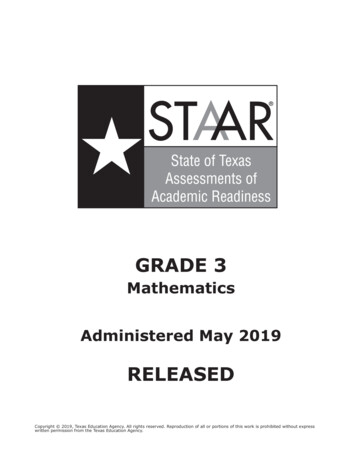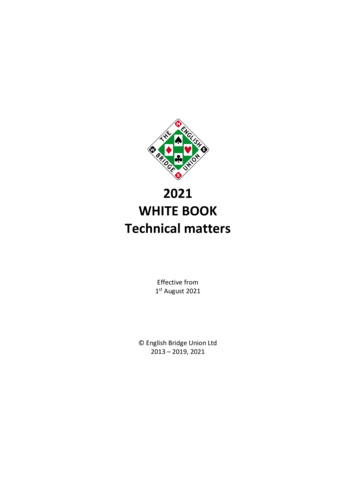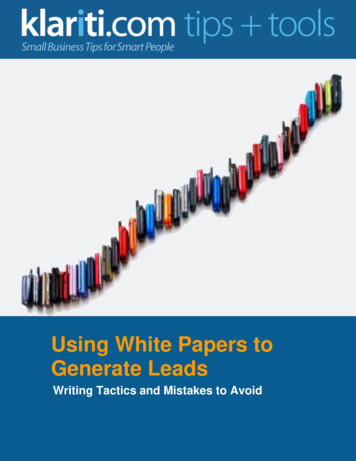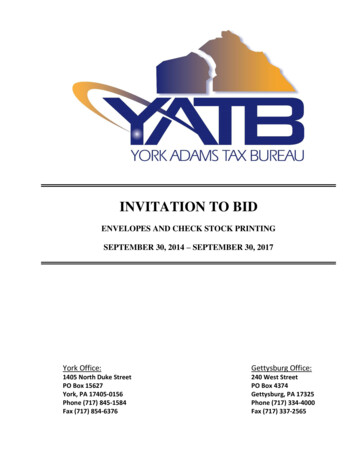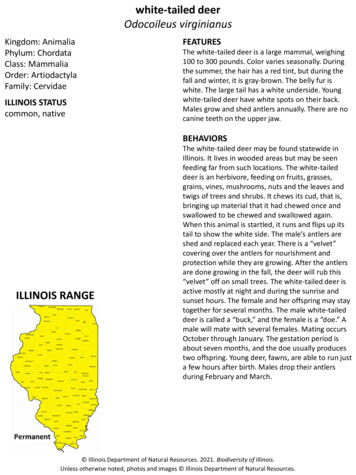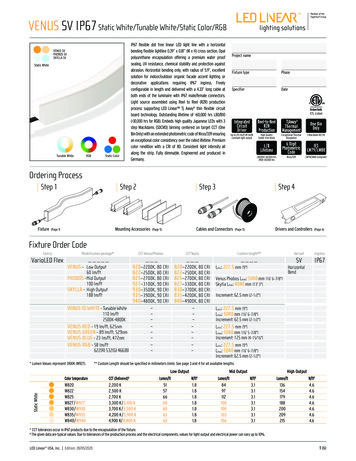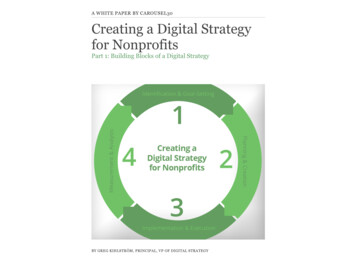
Transcription
A WHITE PAPER BY CAROUSEL30Creating a Digital Strategyfor NonprofitsPart 1: Building Blocks of a Digital StrategyBY GREG KIHLSTRÖM, PRINCIPAL, VP OF DIGITAL STRATEGY
C HAPTER 1Introduction“When we change the waywe communicate, wechange society.”― Clay Shirky, Here Comes Everybody: The Power ofOrganizing Without Organizations
BackgroundThis book is the culmination of years of working with nonprofits, government agencies and for-profit companies on website projects, marketing and advertising campaigns, social media marketing and email initiatives that were critical to thegrowth and success of those organizations. Even more importantly, it is the culmination of getting to know all of those organizations and striving to create cohesivestrategic plans that tie high-level organizational objectives to tactics.In late 2003, it was quite possible a traditional advertising agency would havetaken a slightly different approach to such challenges as growing donations, membership, issue advocates and the like. Carousel30, however, was born in the age ofsocial media startups like YouTube, MySpace, Facebook and Twitter. That hashelped inform our approach to a holistic marketing strategy that balances an organization’s business goals with measurable audience goals. This can be applied toall of your digital properties and tactics, while maintaining a close relationship toyour offline marketing tactics.collecting donations (as opposed to selling goods or services) make some strategiesdifferent.Also, this white paper is geared towards people in a marketing function within anorganization. While we briefly discuss technology infrastructure in Section 5 of thiswhite paper, the primary goal here is to give marketers the building blocks theyneed to do their jobs and to create an initial digital strategy or review the currentone.That being said, I think there is plenty here for anyone who is tasked with creatingor defining their organization’s digital strategy. By the end of the process, you willhave all of the information you need to: Make important decisions about how time and budget are spent. Have clear metrics to determine the effectiveness of your digital propertiesand tactics with your primary and secondary audiences.Finally, you will have a rationale to justify new tactics or make tough choices aboutprograms to cut or avoid.From our experiences, I developed a process to create a digital strategy for any nonprofit organization in a straightforward, simple process that is easy to follow andadjust over time. This is not to say that every organization is the same, but whenyou understand the fundamentals, you can easily modify the process to suit yourorganization’s needs.The Purpose of this White PaperThere are several good white papers, books, articles and blog posts about digitalstrategy out there. What I want to do is fill what I consider to be a void: give peoplewho work at nonprofits a very practical, step-by-step guide to creating a digitalstrategy from scratch and putting a program in place to make it a living documentthat can be continually revisited and refined.I have used this process many times to get great results for clients both small andlarge, with locally focused needs or national campaigns. The best part is that it iseasy to follow, and the elements you need to get started are things you most likelyalready thought through. This approach is simply a way to organize all of yourgoals, audiences and measurable objectives into a clear and strategic plan.This white paper is the first of two parts, and it will lay the foundation for you tocomplete your digital strategy by giving you the building blocks necessary to evaluate, audit and organize all your digital marketing properties and tactics into a clearplan that helps to grow your organization.Who is It for?For this guide, I have put a specific focus on the needs of nonprofit organizations,and it is my hope that many marketing professionals in those organizations will getthe chance to read and utilize these methods to improve their digital marketing endeavors. Overall, the same general principles apply to both nonprofit and for-profitbusinesses, but some specific goals like supporting social causes and tactics such as2
C HAPTER 2What isDigitalStrategy?“Discipline is rememberingwhat you want.”— David Campbell, Founder of Saks Fifth Avenue
A Guide to Help Achieve Your Goals, and Measurements to ShowYou How Well They are AchievedDigital strategy is the process of translating an organization's goals into a plan thatwill create effective digital marketing initiatives. It is the first step in determiningthe tactics that will be used to achieve success for your organization.A digital strategy addresses several aspects of an organization’s needs. It translatesorganizational goals and objectives into a strategy that optimizes the effects thatdigital marketing initiatives have on the organization. This is done through the following:1. Analyzing and prioritizing customer needs and goals that the organizationcan adequately address and improve.2. Identifying opportunities and challenges to the organization as a whole and,more specifically, where digital assets and tactics can help.3. Creating a strategic framework for how digital assets will fulfill business opportunities and customer needs, along with a plan to measure its effectiveness.4. Determining and prioritizing the digital assets and tactics that can deliveron this framework and implementing the appropriate measurement plan.This translates into tactics such as the creation of marketing and advertising plans,technical infrastructure recommendations, reporting and analytics frameworksand plans, and digital brand guidelines and a plan to manage the brand across platforms and mediums.If you are not taking a step towards your goals with the time, energy and dollarsyou are spending to market your organization, you might as well be taking a stepaway from them.While #1 might take on a slightly different meaning for a nonprofit organization —substitute “Revenue” with “Contributions” for instance — the idea remains thesame. For #3, you could easily substitute “Increase Customer Satisfaction” with“Retain Supporters/Donors/Volunteers.”Ultimately, the work that you do as a result of your digital strategy must address atleast one (or more) of these goals to be truly successful. Simply increasing the number of Twitter followers or posts on your Facebook Wall is not enough, unless thoseitems are tied to these goals, but we’ll walk through how to go about doing this aswe go through the process in a later chapter.Similar to those three overall business objectives, a digital strategy has some thingsit must support as well. In Accenture’s podcast, “Leveraging Opportunities in theDigital Age for Banking,” John Keast outlines three things your digital strategyshould support:1) Generating leads2) The ability to direct leads to the right channel3) Increasing conversation rate and enhancing the customer experienceIn the case of a nonprofit organization, a lead would be a potential donor, volunteer or other type of supporter, but the overall idea is the same. We want to createstrategic goals that align with these three things, and then tie them to the overallbusiness objectives we defined earlier. The process we will go through will help youto do this and go well beyond that to identify your primary audiences, their needsand goals, and ultimately create a plan that is both measurable and ties in fullcircle with your organizational objectives.A digital strategy provides your campaigns and projects with guidance and insightto ensure that all of your work is aligned with the overall goals of the organization.You benefit from focused campaigns and tactics that achieve measurable results.Those results are directly tied to the metrics by which your organization bases success.The danger of not creating a comprehensive digital strategy is that you will insteadend up focusing simply on a myriad of tactics that are not directly aligned with organizational goals.It All Starts with Organizational GoalsIn Jim Sterne’s book, “Social Media Metrics,” he outlines the three fundamentalgoals of a business:1) Increase revenue2) Decrease costs3) Increase customer satisfaction4
C HAPTER 3The Process“If you can’t describe whatyou are doing as a process,you don’t know what youare doing.”— W. Edwards Deming
The process consists of five steps of goal-setting and identification, and a sixth stepthat outlines a plan to analyze and adjust over time.In each of the steps, we will focus on tying your goals (organizational or audiencedriven), content and metrics back to results that are easy to define as successful ornot and are directly tied to the success of your organization. Step 1: Organizational Goalso This is where the process starts and what helps define overall success. We take your core goals as an organization and better definethem as executable objectives, as well as highlight any dependenciesand limitations, to set the foundation for your digital strategy. Step 2: Audiences & Personaso Clearly defining your audiences and whattheir needs and wants are will help us define what success looks like from yourconstituents’ perspective. Step 3: Digital Landscapeo This stage outlines the playing field including the properties you will utilize andthe tactics you will execute to reach youraudiences and create conversions. Step 4: Technology Infrastructureo In order to have a successful digital marketing plan and support for your digitallandscape, it is going to require the righttechnology infrastructure. Step 5: Content Strategyo Now that we know who the players are(the audience) and where we are reachingthem (the digital landscape), we will define the types of content and messagingthat will be used to reach them. Step 6: Defining Successo At this point, we have the data necessaryto define what a successful conversionlooks like on all of our digital propertiesand with all of our various digital marketing tactics. We will then create a measurement plan that incorporates all of the goals per audience and property and tie them back to the original organizational goals. Step 7: Plan, Analyze & Adjusto The final step is an ongoing process of planning, analysis and adjustment based on the success of your efforts. We will cover the first partof this, planning, in the next white paper. The planning stage iswhere you actually create your digital strategy and subsequent tacticsbased on the work you have done up until this point. This is also thepart that will be regularly reviewed and adjusted as necessary as yourorganizational and/or audience goals shift. A solid digital strategyshould support small shifts and adjustments, so that you don’t haveto constantly redo Steps 1-6.At the end of this process, you will have all the information, from goals to a fullview of your digital landscape, and an exhaustive list of your conversion metricsthat will be used to create your digital strategy.6
C HAPTER 4Step 1: GoalSetting“There are those who travel andthose who are going somewhere.They are different and yet they arethe same. The success has this overhis rivals: He knows where he isgoing.”— Mark Caine
The first step in the process is to make sure you understand both your organizational goals and your audience goals. Everything else you do will be dependent onthis step.Organizational BackgroundWhile there is doubtless much information already in existence about your organization, it’s important to define your organization and its place within your industryas you begin to build your digital strategy. This goes well beyond your place in theonline world and includes the change in the world that your organization hopes toachieve. It will undoubtedly include your place in the online world, but dependingon your business model, properties like your website might simply be a tactic toachieve a greater goal. On the other hand, if your company’s central presence is online instead of brick and mortar, your Web presence might play a greater role here.Think big: what is your organization’s mission and vision for the future of your industry or the cause(s) you support?To put your digital strategy together, write one to two paragraphs that frame yourorganization’s mission and purpose. This will make it easy to apply audience goalsdown the road. Speak to the different types of work you do, products you offer, andso on. You have now set the context for everything that follows.ganizational goals is to reinforce that each of the goals and tactics used in your digital strategy should align with at least one of your organizational goals.As stated in the previous section, your high-level organizational goals are going tobe centered around three things:1) Increasing revenue2) Decreasing costs3) Retaining supporters/donors/volunteersDependenciesIt’s important to define the constraints and dependencies that help define both thelimitations of scope, as well as the approval process, technical infrastructure andother organizational initiatives that either provide additional insights or barriers tothe completion and execution of a digital strategy.Stakeholder and Departmental GoalsThere are many stakeholders in an organization’s digital strategy. Some ofthese might only be tangentially related, but the success of the plan dependsin some part on the success of the stakeholders and their individual or collective objectives. Make sure to define any stakeholder goals that are not duplicative of the overall organizational goals.Offline Tactics/CampaignsA digital strategy is always part of a larger communications and marketingplan. Integrating your digital and traditional efforts requires careful coordination and you will find the most success when the two are aligned. Makesure to note your offline campaign dependencies. This might be the timingof a direct mail campaign or telephone fundraising drive, or it might be anannual gala or event.BudgetaryIn a perfect world, money would be no object, but your nonprofit organization’s digital plans are constrained by a budget. This is not simply a dollaramount; it is also dependent on your fiscal year, monthly cash flow, andeven the amount of staff or volunteer time available. Make sure to provide awell-rounded summary of the budgetary constraints that will affect thescope of your digital strategy.Organizational GoalsYour organizational goals are used to form your digital strategy, but they are notnecessarily solely dependent on digital tactics. The purpose of outlining these or-Technical InfrastructureTechnical infrastructure can be a large investment for an organization andany dependencies here might include server software requirements, legacyCMS or CRM systems, or skill preferences of existing staff. This helps set thestage for budgetary needs as well as the scope of specific tactics like a website redesign. Make sure to differentiate between items that are required tobe used (e.g. your organization signed a 5-year contract with a CRM vendor)and that are simply a preference (e.g. your IT team prefers open source technology).8
ChallengesIn addition to dependencies, outline some challenges that pertain to achieving your goals. These could be based on previous marketing efforts or otherexternal factors. Try not to be too audience-specific and focus more on organizational challenges – we will get to audience-specific challenges in thenext step.What to do in Step 1:In the Appendix of this document, there is a worksheet in Step 1 that helps youidentify these elements.Goal ondaryG2:G3:Recap and Next StepsAt this point in the process, we can already see at a high level what we wouldlike to accomplish and how we can start making a plan to achieve it, simplybased on overall goals, dependencies and challenges. We don’t need to getvery specific in our recommendations at this point, but we should have agood sense of our overall expectations and limitations. In the next step, youwill think more about your primary and secondary audiences and your goalsfor each.9
C HAPTER 5Step 2:Audiencesand Personas“To create a product that must satisfy a diverse audience of users, logic might tell youto make it as broad in its functionality aspossible to accommodate the most people.This logic, however, is flawed. The best wayto successfully accommodate a variety of users is to design for specific types of individuals with specific needs.”— Cooper, Reiman, Cronin, About Face 3: The Essentials of Interaction Design
In this step, we will be defining primary and secondary audiences and what theirpurpose of interacting with your organization is, as well as what your definition ofa conversion or goal for that audience is from your organization’s perspective.ment keeps high-value donation amounts tracked in a separate CRM or databasefrom lower-value website donations, you might have to work to correlate the two,or you might need access to both to track both audiences.For instance, for a primarily fundraising-based organization, you could have twoprimary audiences: 1) high-value donors, and 2) grassroots (low dollar, high volume) donors. Each audience obviously has very unique needs and might be motivated by different calls to action. For instance, a conversion for the high-value donors might end with a phone call to your development department rather than acredit card donation. As you define your audiences, be sure to keep in mind how you will begin to track them and measure your success.AudienceNameYour sonas are a very useful part of a website redesign process as well and have been a staple ofuser experience (UX) professionals for years. Inthis step, we are going to create a hybrid of thetype of audience profile that you might use todevelop a marketing plan and a persona thatyou would use to create use cases for a website.As a rule of thumb, try to create three primarypersonas (designated as “A” audiences) and twoto three secondary personas (“B” audiences).You might have more audiences, which is fine,but keep in mind that the more audiences you have, the more planning and resources you will need to market, track and convert.MeasurementMetricAudience-Specific OrganizationalChallengesRecap and Next StepsWhile you already knew your audiences for your digital marketing efforts,this step should have clarified what they want, how to reach them and howyou can track the effectiveness of your efforts.In the next step, we are going to take a look at the entirety of your digitallandscape, so you can begin to tie the various communication outlets to yourprimary and secondary audiences, all while adhering to your overall organizational goals.What to do in Step 2:In the worksheet for audiences in the Appendix, we list the following categoriesthat should be filled out for this step: Primary Audienceso Nameo Descriptiono Needso WantsSecondary Audienceso Nameo Descriptiono Needso WantsThen we tie each audience to their specific goals and your organizational goals,along with the metric you can use to measure them. It is also important to defineany challenges that you may have in measuring this. For instance, if one depart-11
C HAPTER 6Step 3:DigitalLandscape“We are the children of ourlandscape; it dictates behavior and even thought inthe measure to which weare responsive to it.”—Lawrence Durrell
Your digital landscape is your organization’s comprehensive presence on the Web,from websites, microsites and mobile apps to social media presences and beyond.At this point, it is important that we get the lay of the land so you can begin to better understand how your organizational and audience goals can be achieved by strategic use of all your properties. I recommend creating a diagram similar to the onebelow that shows where your brand exists online. Be exhaustive in your listing anddetermine the flow of traffic and content to and from each touch Google DigitalAdvertisingCampaignsSocial ContentDrivesTrafficTactics are similar to your digital properties except that theydo not have a static destination where they exist. Exampleswould be an email campaign, digital display ads, public relations efforts, etc.While your tactics might behave differently than your digitalproperties in a number of ways, they can be simplified down tohaving similar characteristics such as: Target Audiences Goals Audience-Specific OrganizationalEnumerating your tactics the same way you list your Web properties will help with the next step, which will be your contentstrategy. It also forms a comprehensive view of the touchpoints you have with your audiences.Conversion MetricsDrivesTrafficEventMarketingYour digital properties include websites and other destinationslike a social media presence. Most likely these are places on theWeb that your organization has control over from a contentand branding perspective, though sometimes (e.g. partner websites) you may have limited control. In order to distinguish between those that you have full control versus partial control,make a list and differentiate between the two using a termsuch as internal and external, or something tionalMarketing,Advertising,PRWe are going to make the distinction here between properties and tactics. Essentially, your properties are virtual presences that you own or manage and that canbe linked to for an extended period of time. Tactics refer to timely things, such asemail campaigns or events, which may only exist for a short period of time and generally send Web traffic to other destinations or properties.The next step is to define what successful use of each of these properties or tacticswill result in. We call this a conversion. Some common conversion metrics are:13
Successful completion of a donationSigning up for an email listSharing content on FacebookSigning a petitionRegistering for an eventClicking on an advertisement, going to a campaign landing page, then clicking a learn more buttonWe want to define each of these conversion events so that we can set the measurements in place to determine the effectiveness of our efforts. For instance, a conversion pathway might be something like the workflow on the previous page.Thus, we want to make sure that we add “successful donation” to our list of conversion metrics for both advertising and the website. We will then tie these both to ouraudience and organizational goals from earlier, and we will go on in the next stepsto tie these to a measurement plan to report on the effectiveness of our donationpathway.Recap and Next StepsNow that we have outlined all the properties and tactics you are using inyour digital marketing, as well as the conversion methods they employ, wecan trace backwards through our process to see the audiences that theyreach and the audience and organizational goals they support. We are halfway finished with the work of enumerating the breadth and depth of yourdigital strategy.In the next section, we’re going to talk about content. Content can be text,but it can also be images, video, as well as social media comments and otheruser-contributed items. Just like we defined all of our Web properties andtactics, we’ll do the same with the content that we produce.We will also return to this idea of a multistep process, or funnel, later in this document. Note how, while there is only one measure of success (a completed donation), there are several steps in this donation process as described above. We willwant to define such pathways in Step 5, where we talk about measuring our success.What to do in Step 3:In the Appendix, there is a table that addresses your digital landscape that lookslike the table below. You can see that we are now making sure that we add theproperties/tactics into our process and tie them back to both organizational andaudience-specific goals. At each step in the process, it’s important to do this, as itclearly defines the relationship between everything you do and the way that it canbe measured, as well as the way that it contributes to the goals of your organization.The table below shows how this can be GoalsAddressed:AudienceSpecific or:ConversionMetricInternal (organization-managed)External (not managed by organization)14
C HAPTER 7Step 4:TechnologyInfrastructure“Hardware: where the people in yourcompany's software section will tell youthe problem is. Software: where the people in your company's hardware sectionwill tell you the problem is.”—Dave Barry, Claw Your Way to the Top
OverviewRecap and Next StepsYour technology infrastructure supports both external and internal communications, including your digital marketing properties and tactics, as well asinternal functions such as email, document storage and more.Because this white paper is primarily targeted to marketing professionals,not technology professionals, the content will only touch on the basics of therequirements for a proper technology infrastructure.Now that we have outlined all the components of your technology infrastructure, you can begin to assess the effectiveness of each, how it supports yourdigital marketing efforts and make decisions that can decrease cost and increase the efficiency and effectiveness of your organization’s efforts.In the next section, we’ll cover content. Content can be text, images, video,as well as social media posts and other user-contributed items. Just like wedefined all of our Web properties and tactics, we’ll do the same with the content we produce.Your Current Technology InfrastructureA proper technology infrastructure can be divided into several components: Externalo Website Content Management System Hostingo CRM Membership Fundraising Communication (Email)o Marketing & Advertising Email Marketing Search Engine MarketingInternalo Emailo Document Storage & Sharingo Software16
C HAPTER 8Step 5:ContentStrategy“Without a content strategist, who will objectively assess the efficacy of current contentagainst brand strategy and communicationgoals? Who will audit existing content for quality, currency, and relevance? Who will createkey messages and develop content to supportuser decisions along the way? We haven’t evengotten to writing yet!”— Margot Bloomstein, The Case for Content Strategy Motown Style
Content StrategyMessageMissionTone/VoiceAudienceTypes tedsitesContent is a large component of any digital strategy because while your digital landscape is where you are reaching your audience(s), your content is how your organization is communicating. Even if you are not an organization whose primary offering is content (such as a magazine or blog site), content still plays a huge role inyour communications.The idea behind your content strategy is to communicate: Effectively: Produce the right content for the right audience.Efficiently: Organize and produce content in a way that reduces redundancy and allows all of the departments and channels of your organizationto easily create communications.Appropriately: Use the right tools to communicate with the right onsEditorialCalendarRelease ofotherContentMediaReleasesthings like organization description, case studies, blog posts, press releases,team bios, status posts and other pieces of content that are unique in theirsubject and purpose.AudiencesYour audiences were defined in Step 2. The important thing here is to ensure that you tie each type of content to one of your primary or secondaryaudiences.DeliveryProperties and tactics were defined in Step 3. The purpose of including themin your content strategy is to make the connection between where your content resides, what audiences it is connected to, and what goals it addresses.TimingMessageMission/VisionThe mission/vision should align with your organization’s branding guidelines and overall goals.ToneTone refers to the personality and way you write to your audiences. Generally, you want to have consistency across your brand so that all audiencesshare a common experience, but there are times when a different approachor voice resonates more with one audience than another.Types of OutputThis refers to the different types of content being written. This doesn’t referto something as general as text on the website, but more specifically toEditorial CalendarYour organization’s editorial calendar is the schedule by which content andinformation is released. This should include both a time and topic-basedbreakdown. Simply saying that blogs will be written twice a week doesn’tadequately convey the direction of the content that is being produced byyour organization. Most likely, if you have a digital editorial calendar, it willbe based somewhat on a broader organizational one, which is a good thing.Just as your digital tactics relate to your traditional tactics, the content youprepare for your digital properties must support and augment content produced for your other efforts.Media RelationsYour content strategy needs to incorporate ties to your organization’s mediarelations efforts. This could be making sure that blog content pertaining torecent press releases is readily available, status posts on social media an-18
nounce releases, or even simply that press releases are available on yourwebsite.Content ReviewHow often does the content need to be reviewed for accuracy, timeliness andalignment with what is currently happening at the organization? For a website, descriptions of key focus areas or case studies might need to be eitherreviewed or rewrit
cies and for-profit companies on website projects, marketing and advertising cam-paigns, social media marketing and email initiatives that were critical to the growth and success of those organizations. Even more importantly, it is the culmi-nation of getting to know all of those organizations and striving to create cohesive


